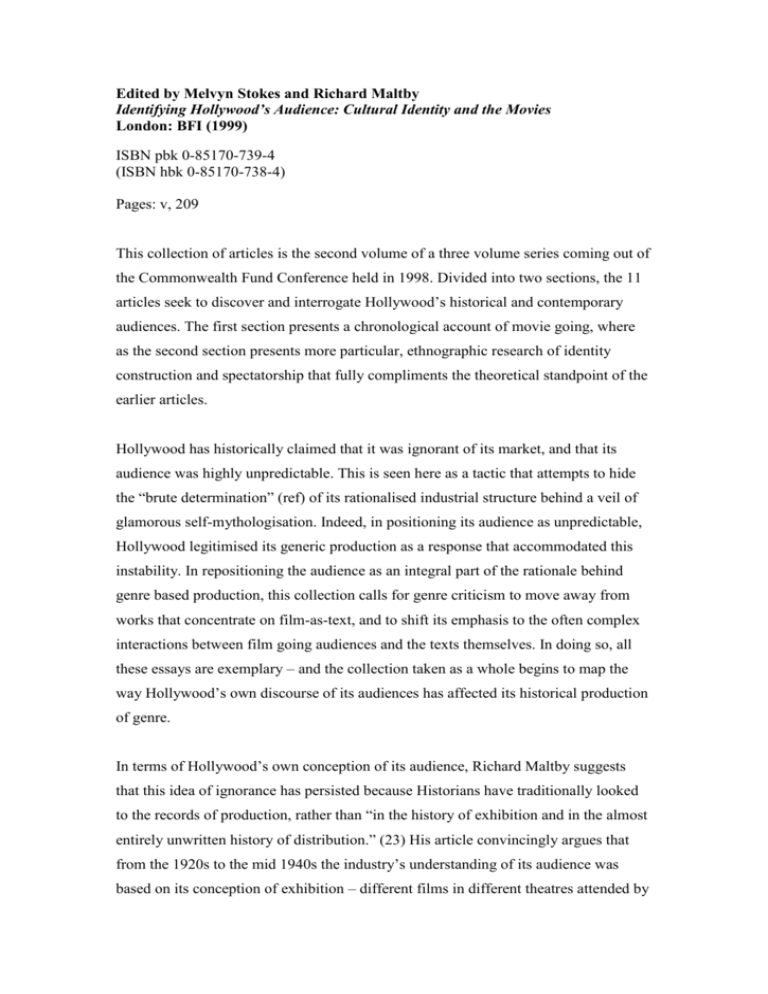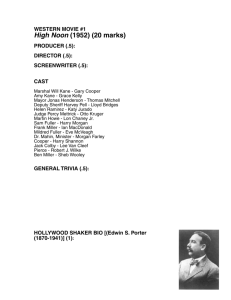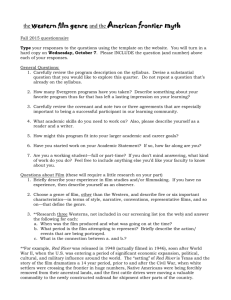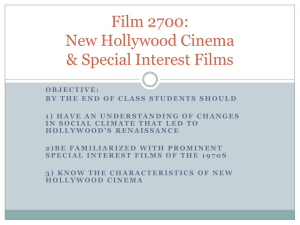Identifying Hollywood`s Audience: Cultural Identity
advertisement

Edited by Melvyn Stokes and Richard Maltby Identifying Hollywood’s Audience: Cultural Identity and the Movies London: BFI (1999) ISBN pbk 0-85170-739-4 (ISBN hbk 0-85170-738-4) Pages: v, 209 This collection of articles is the second volume of a three volume series coming out of the Commonwealth Fund Conference held in 1998. Divided into two sections, the 11 articles seek to discover and interrogate Hollywood’s historical and contemporary audiences. The first section presents a chronological account of movie going, where as the second section presents more particular, ethnographic research of identity construction and spectatorship that fully compliments the theoretical standpoint of the earlier articles. Hollywood has historically claimed that it was ignorant of its market, and that its audience was highly unpredictable. This is seen here as a tactic that attempts to hide the “brute determination” (ref) of its rationalised industrial structure behind a veil of glamorous self-mythologisation. Indeed, in positioning its audience as unpredictable, Hollywood legitimised its generic production as a response that accommodated this instability. In repositioning the audience as an integral part of the rationale behind genre based production, this collection calls for genre criticism to move away from works that concentrate on film-as-text, and to shift its emphasis to the often complex interactions between film going audiences and the texts themselves. In doing so, all these essays are exemplary – and the collection taken as a whole begins to map the way Hollywood’s own discourse of its audiences has affected its historical production of genre. In terms of Hollywood’s own conception of its audience, Richard Maltby suggests that this idea of ignorance has persisted because Historians have traditionally looked to the records of production, rather than “in the history of exhibition and in the almost entirely unwritten history of distribution.” (23) His article convincingly argues that from the 1920s to the mid 1940s the industry’s understanding of its audience was based on its conception of exhibition – different films in different theatres attended by different types of “community and class patronage” that classified the audience in particular ways. Melvyn Stokes’ article is concerned with these classifications in terms of gender, and examines the importance of the female spectator in the 1920s and 1930s, and the effect of this on the development of the star system, fan cultures, and the eventual emergence of the “women’s film” as a distinct genre. Like many articles in this collection, Stokes re-examines historical data, and here uses “movie autobiographies” (ref) that were taken as part of the famous Payne Fund Studies. Similarly, Susan Ohmer examines Gallup’s methods of audience research, arguing this constructed a discourse that ultimately attempted to control audience reactions, and served marketing, rather than consumer interests. Indeed, the way in which Hollywood has imagined its audience is vital to the understanding of its production decisions – a key theme in this collection. In the articles by Sklar and Kramer, Hollywood’s imagined audience of ‘modern women’ had shifted by the 1960s, and was replaced by a 19 year old male as the target audience, whose imagined influence still dominates the production of male-oriented blockbusters today. Alongside this imagined male audience, Allen then investigates what he calls the rise of “postmodern family entertainment” since the late 1980s. He charts the production of the family film at this time, emphasising the way in which these productions are no longer self-contained texts, but revolve around product tieins and merchandising. The phenomenon of synergies and licensed tie-ins has become so prominent a feature of production today that Allen convincingly proclaims Hollywood film making as we have previously understood it, is dead. Part two of this collection is concerned less with the re-examination of Hollywood’s discourse on its audience, and instead concentrates on listening to audiences themselves. Firstly, Kuhn’s beautifully written article on what she calls “enduring fandom” uses oral histories of cinema going in Britain in the 1930s, and asserts the social nature of film going in these accounts, providing a more complex and nuanced understanding of how media texts and their audiences interact. Austin goes on to explore a group that is under-studied in this area, and challenges the assumptions of a simplistic, paternalistic and heterosexual “male gaze” in his examination of responses to the film Basic Instinct (1992). By looking at the interaction of spectatorship with expectations produced by film promotion, Austin reveals the complex way in which young straight men negotiate their identities often outside of critical assumptions of voyeuristic and sadistic pleasures. Barker and Brooks’ article shares a similar concern to re-negotiate the idea of a homogenous male gaze by research into spectatorship of the film Judge Dredd (1995). The final two articles deal with spectatorship of violence and horror; Hill’s article examines the way in which the experience of screen violence can be theorised outside of the problematic media effects tradition, and in the final piece, Berry examines female spectatorship of the horror genre, that largely takes place in private. This collection makes a serious contribution to audience studies, however its strength lies in the equal contribution it makes to our understanding of the intersection between genre and audience. This book makes a valuable addition to any collection, and is suitable for those with an interest not only in audience studies (where its theoretical concerns may be seen as ‘preaching to the converted’), but will appeal equally to those with an interest in genre, ethnography, and Hollywood as a cultural industry. Karina Berzins











